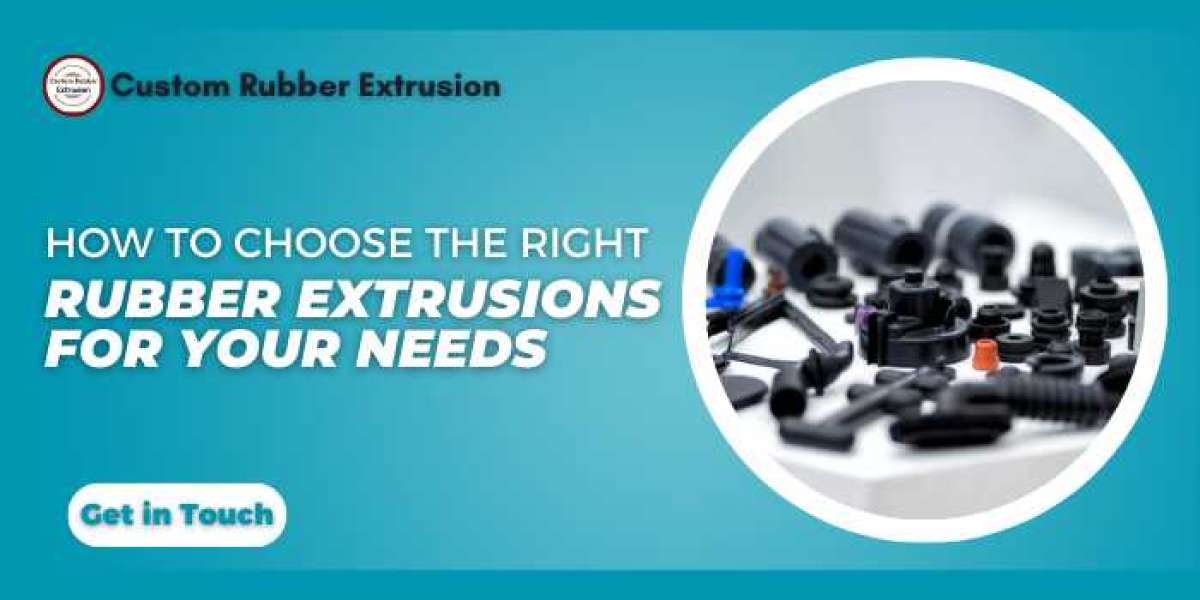Rubber extrusions are becoming very popular in many industries, especially in the automobile and construction industries. Its primary function is to provide essential ingredients that ensure durability, safety, and functionality. The versatile product is manufactured when rubber is molded through a die to produce various profiles, including seals, gaskets, and tubing. With many types of rubber extrusions available in the market today-mostly custom rubber extrusions, solid rubber extrusions, and custom silicone extrusions, what would be considered suitable will depend on what kind of application they will be used for. Even to carry quality performance, improper selection might not work as expected and can deteriorate even further without effectively fulfilling their desired functions.
Understanding Rubber Extrusions
Rubber extrusions refer to profiles that result from forcing raw rubber material through a specialized die. They become continuous shapes that can be cut to varied lengths depending on requirements. Such extruded products come to be used to seal gaps, cushion surfaces, and even dampen vibrations that could impact the system or procedure to which they are attached. They find applications in diverse industries.
There are two types of rubber extrusions: standard and custom. Standard extrusions refer to pre-designed profiles for most applications. In contrast, custom rubber extrusions are made according to a specific requirement to achieve unique dimensions, shapes, and material properties according to particular needs.
Rubber extrusions are also widely used in the automotive and manufacturing industries. Their application in automobiles is crucial since sealing and insulating many parts inside a vehicle is necessary for comfort and safety; in manufacturing, they are used in several machines and equipment to make them more performant and reliable.
Types of Rubber Extrusions
1. Custom Rubber Extrusions
Custom rubber extrusions are profiles specially designed to satisfy specific requirements for any unique application. They are essential if the standard options available do not satisfactorily meet the requirements of a project due to some dimensional constraint, the requirement for unique material properties, or exceptional performance characteristics. Business organizations are assured with custom solutions that the particular extrusions fit into their systems perfectly and will function ideally in all conditions. The benefits of custom rubber extrusions over off-the-shelf products lie in better compatibility, performance, and the ability to use specialized materials that might not be found in standard profiles. This customization allows for better functionality and, therefore, contributes more towards the general success of the application.
2. Solid Rubber Extrusions
Solid rubber extrusions are continuous profiles of rubber with no hollow sections. These are heavily used for sealing and gasketing applications or as a bumper, where the emphasis is on strength rather than pliability. Their strength from the solid structure makes them useful in aggressive environments such as automotive and industrial use. The direct benefits of these solid rubber extrusions are that they improve performance due to greater capacities to bear loads. This is possible because it can withstand hard conditions such as heat extremes and chemical exposure. They are durable enough to continue unbroken and functional for extended periods. This automatically means less frequent renewal and repair are needed.
Key Factors to Consider in the Selection of Rubber Extrusions
1. Application Requirements
The requirements of the intended application should be the prime considerations in rubber extrusion selection, be it for automotive or industrial use, amongst others. Different applications will demand different requirements, such as flexibility and hardness, other desirable properties and resistance to environmental factors. For example, rubber extrusions in the automotive industry will be exposed to a wide temperature variation, oil contact, and mechanical stress. In industrial applications, higher abrasion resistance may be needed. Consideration of the environment in which the rubber is used, including UV light, chemicals, or moisture, is essential in selecting the right extrusions that will perform and last well.
2. Material Selection
Material selection determines the performance and durability of rubber extrusions. Among the most commonly used materials are silicone, EPDM (ethylene propylene diene monomer), and neoprene, each with distinct properties for different applications. Silicone, for example, is often cited as resistant to temperature variation and flexibility and, where custom-designed silicone extrusions apply, can be used in very demanding applications. EPDM is the most weathering and ozone-resistant material, ideally suited for outdoor use. The suitable material will give you the best performance, life cycle, and low-economic rubber extrusion solutions.
3. Manufacturing Capabilities
Getting the manufacturer experienced in producing custom extruded silicone products proves to be the most significant factor in ensuring high-quality results. Only an experienced manufacturer will be able to understand the intricacies involved in rubber extrusion processes, along with the possibility of creating precise and reliable profiles according to your requirements. Quality assurance is also integral to the whole manufacturing process. Only through strict quality control measures will the extrusions meet all of the required standards and specifications, thus reducing the risk of defective products and improving the product's overall reliability. The proper manufacturer will hence help make your rubber extrusions a success.
Industry-Specific Considerations
1. Automotive Rubber Extrusions
Automotive rubber extrusions must be subjected to stringent exposures because they come into contact with automobiles. The extrusions must provide safety for sealing insulation and dampen vibration. They must also have the strength to face conditions of extreme temperature, moisture, and chemicals of various types. Automotive rubber moldings are critical in ensuring the safety and efficiency of a vehicle. They prevent water and air leaks, reduce noise, and shield sensitive components. Hence, effective quality extrusions play a significant role in enhancing the efficiency of a vehicle and making it comfortable for drivers, which in turn becomes a critical element in the design of automobiles.
2. Other Industry Applications
Outside of the auto industry, rubber extrusions play a significant role in many other sectors, including building, electronics, and aerospace. In the case of construction, they seal and weatherproof to ensure that buildings are energy efficient and comfortable to be occupied. In electronics, rubber insulates and protects wiring and components, ensuring their functionality and safety. Therefore, versatility in rubber extrusions adds more value to its being an indispensable component of myriad applications cutting across various sectors, essentially calling for proper choice that meets the specific needs of the industries.
Conclusion
Nothing is better than suitable rubber extrusions to ensure optimality in performance, durability, and safety in various applications. For automobile, construction, or electronics applications, the difference between using one over the other could go a long way in determining the effectiveness and longevity of your products. With so much going on in material selection and design specifications, it would also be best to ask experts or manufacturers to have custom rubber extrusions. With this experience and knowledge, you can make informed decisions about what best meets your needs, improving your applications' quality and reliability.














